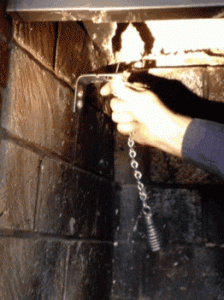With the start of the New Year comes the coldest weather of the season, and staying warm becomes a top priority. At this point, most Illinois homes have had the heat running for several months now. Keeping the house warm is not the only priority, though. Running the furnace, boiler, or fireplace costs money, so homeowners must think about ways to cut costs when heating the house. For those utilizing fireplaces or wood stoves, there are quite a few options available for saving money. One option that tends to be forgotten is the damper.

The damper is a mechanism in the chimney that opens to permit the flow of air. Usually made of metal or ceramic to withstand high heat, the damper opens and closes using a handle, lever, or pull chain. Most fireplaces have chimneys with dampers, and the damper must be opened prior to starting a fire. It should also remain open until the fire has been extinguished and allowed to cool completely. When the fire has cooled or when the fireplace is not in use, the damper should stay closed to keep warm indoor air from escaping through the chimney.
Energy savings come into play depending on where the damper has been installed. Oftentimes, the damper is throat mounted, meaning it sits just above the fireplace at the base of the chimney. The other common location for the damper is at the top of the chimney, and these are known as top sealing dampers. Throat mounted dampers cost less to install, which is why builders commonly install those instead of top sealing dampers, but they cost more money from inefficiency in the long run.
Top sealing dampers save money on fuel efficiency because of the way they affect the flow of air in the chimney, also known as the draft. In order for the fire to burn effectively and to keep the smoky air from filling the house, the direction of the draft must go from the house into the fire and up through the chimney. Prior to starting a fire, the warm air from the house is allowed to fill the chimney with a top sealing damper, whereas the chimney is full of cold outside air with a throat mounted damper. When starting a fire, the warmer chimney with the top sealing damper allows a proper draft to start right away. On the other hand, the hot air from the fire takes much more time to move up through the cold chimney, which can result in a cool fire, a smoky fire, or a fire that will not even light. All of these results waste fuel, be it gas, wood or a combination.
If you are concerned that your damper is wasting you too much money, time, and energy, you can opt to have a top sealing damper installed. If you live in the Elkton, Maryland area, contact Ace Chimney Sweeps for a professional consultation.
